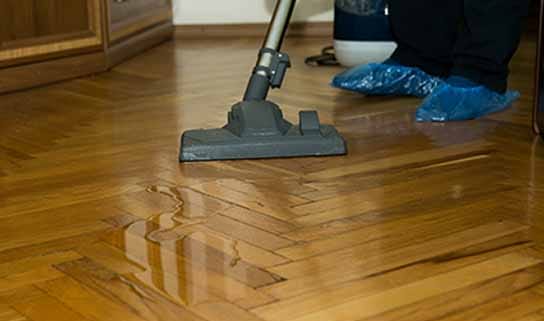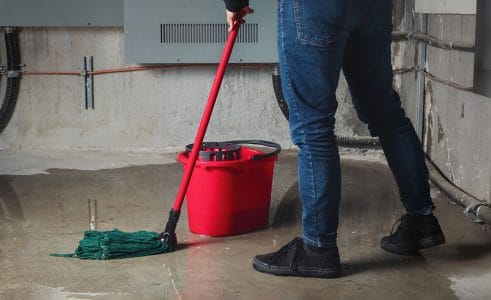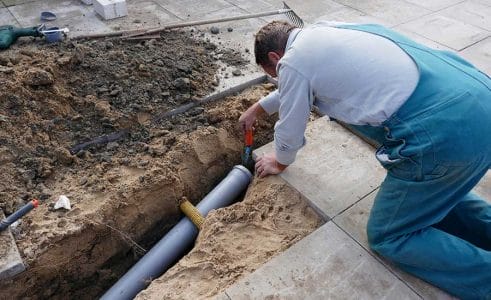What To Do When Your Basement Floods

Flooded basements can damage both the structure and contents of your home and pose safety risks.
To help you handle a flooded basement safely and effectively, we’ve compiled a list of steps to take if you find yourself in this situation.
Why Do Basements Flood?
There are several reasons why your basement might flood, including:
- Foundational cracks
- Burst or leaking pipes
- Leaking appliances
- Water heater leak
- Backed-up drainage system
- Sump pump malfunction
- Sewage system backup
- Heavy rainfall or snowmelt
- Overflowing bathtub or toilet
While it’s possible to prevent some of these causes with annual inspections of appliances and drainage systems, even the most prepared homeowners can end up dealing with a flooded basement.
Dangers of a Flooded Basement
When a basement floods, damage is inevitable. Furniture and other items can be ruined, while carpets and floors may become waterlogged and start to grow mold.
Beyond property damage, flooded basements also pose serious health and safety risks.
Here are a few dangers that can occur when a basement floods:
- Severe flooding or untreated water damage can compromise the structural integrity of your home and foundation
- Electrical shocks may occur if floodwater reaches wires or electrical components
- Floodwater can cause system failures in basement appliances like HVACs, water heaters, and washers and dryers
- Floodwater is often contaminated with harmful chemicals, bacteria, and other substances unless it comes from a clean source, such as a broken supply line
If you’re concerned about these dangers in a flooded basement, it’s best to contact a professional water damage restoration service.
How to Manage a Flooded Basement
Since flooding can result in different disasters, including mold growth and other secondary damage, we recommend hiring professionals for effective remediation in any basement flooding situation.
For moderate to severe floods, especially those involving contaminated water, always call a qualified property restoration company.
If the flooding in your basement is minor and involves only clean water, also known as Category 1 water, there are several steps you can take to help limit the damage.
1. Shut Off the Power
Even a small amount of water can reach electrical sources like cords, wires, and floor outlets.
Before you locate the source of the flooding, make sure to shut off all power to the basement. If you can’t access the power controls, contact an electrician or your utility company.
2. Locate the Source of the Flooding
Once you’ve confirmed that the power is off in the basement, the next step is to identify the source of the flooding.
For some issues, like a failed water heater, you might be able to handle the problem yourself. However, if the flooding is due to a burst pipe or a backed-up drainage system, you’ll need professional help.
If you must enter a flooded area, wear proper personal protective equipment (PPE), such as protective rubber boots and gloves. If the water is deeper than your boots, it’s best to call a professional water extraction and drying service.
Remember, floodwater can be dangerously contaminated, especially if it comes from an uncertain source or has been stagnant. Avoid contact with potentially contaminated water.
3. Remove Water
If you’ve safely located and stopped the source of the flooding, the next step is to remove any standing water. Utility pumps and wet vacuums work well for removing small amounts of water from a basement floor.
If the water in your basement comes from an unsanitary source, regardless of the amount, it’s best to let a property damage restoration professional handle the water extraction.
They are equipped with the necessary personal protective equipment, proper tools, and specialized containment methods for these situations.
4. Dry Out the Basement
Even if you’ve removed the bulk of the floodwater, there is likely to be built-up humidity in the basement due to trapped moisture.
Excessive moisture indoors can lead to further damage, as well as mold and mildew growth.
You can use dehumidifiers and fans to continue drying out your basement and help restore its normal humidity levels.
Opening any basement windows (given that they aren’t the source of the flooding) can also help to air out the basement, but only if outdoor humidity levels are lower than those indoors.
5. Clean the Basement
Once you’ve sufficiently removed the water and reduced the humidity, you can start cleaning the basement and removing any items damaged by the flooding.
If you’ve called in a restoration professional, they can advise you on which items you can salvage.
If your flooded basement involved any level of contaminated water, the restoration company will also perform the necessary cleaning and antimicrobial application to eliminate potential health risks, such as skin rash.
6. Look for Mold and Mildew
Mold and mildew can lead to additional damage and impact the health of those living around it. It’s important to check if mold has grown anywhere in the basement because of the flooding.
BELFOR offers mold removal and remediation services to safely deal with extensive mold growth.
Who Should You Contact When Your Basement Floods?
Depending on the severity of the flooding to your basement, there are different professionals or services you may need to call, such as your home insurance provider, an electrician, a plumber, and a restoration company equipped for flooded basement cleanups.
At BELFOR, our water extraction and drying service include:
- Source elimination
- Loss mitigation
- Identifying type and extent of damage
- Evaluating loss
- Water removal
- Drying
- Antimicrobial application
Contact your local BELFOR office today or get in touch using the BELFOR Mobile App, and get started with professional flooded basement cleanup service to help limit damage to your property.
.jpg)


